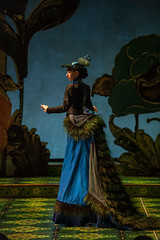 The Jungle Book creative team at the Taj Mahal: TJ Gerkens, Dan Ostling, Ajay Rathore Singh, Leo Chiang, Mara Blumenfeld, and Doug Peck. |
When Disney Theatrical Group conceived of a stage version of the classic 1967 film The Jungle Book, they easily could have set out to create a replica of the movie that for decades has captivated generations of children with its celebratory music and lovable characters. Instead, they tapped Tony Award winner Mary Zimmerman, one of theatre’s most innovative directors, to reimagine their hit as a wholly original new work to be felt and experienced live at the theatre.
The Jungle Book has many of the hallmarks of a Mary Zimmerman adaptation. But this production posed additional complexity for the adaptation, as it draws from not one but two sources — both the 1894 Rudyard Kipling stories and the 1967 Disney animated film. Tonally, Kipling’s stories are poetic and his jungle is at times dark and violent, while in contrast, the Disney movie, set to the jubilant sounds of American swing and jazz, is fun and celebratory.
In the process of exploring how to balance the divergent elements of her two sources, Zimmerman found inspiration in Kipling’s personal biography: he was born in Bombay to English parents and lived in India until he was six years old when his parents sent him back in England. There, they left him in the care of a woman who ran a school out of her home, and, unbeknownst to them, physically and emotionally abused him until he left at age 10. Years later, when Kipling was a newly-married adult living in Vermont, he wrote the stories of The Jungle Book.
 Nikka Graff Lanzarone as Peacock in The Jungle Book. Photo: Liz Lauren |
“There is an almost desperate energy behind the creation of this world that was psychologically necessary for him,” Zimmerman said. “The romanticization and exoticism of India that he’s come to be criticized for, he’s come about in a well-earned way: he was born there and he lost it. He lost India as a child, and a child about the age of Mowgli.” Zimmerman drew from the stark contrast between Kipling’s happy early childhood in India and his fraught later years in England to establish the emotional tenor of the production. “I want the audience to experience the joy of that music and of living in a world where you are one with nature and the animals — even with all its dangers and its troubles. And also the recognition that you can’t stay there.”
In order to create her living jungle, Zimmerman and her team plunged into their design process, which is research heavy, immersive, and highly collaborative. She almost always works with the same design team — set designer Daniel Ostling, costume designer Mara Blumenfeld, and lighting designer T.J. Gerckens. When creating The Jungle Book, Zimmerman immediately recognized the need to honor its setting through design. “My very first impulse when this idea came up was to take the forms of Indian representation — visual and musical — seriously within the aesthetic of doing the show.” In order to capture the sights and sounds of Kipling’s India, the team spent two and a half weeks traversing the country — visiting 10 cities in one trip — listening to music on the streets, gathering textiles at markets, interacting with indigenous animals, and taking “thousands and thousands” of photographs.
 Monique Haley (Elephant), Akash Chopra (Mowgli), Ed Kross (Colonel Hathi), and Anjali Bhimani (Baby Elephant) with the rest of Colonel Hathi’s elephant army in The Jungle Book. Photo: Liz Lauren |
The world that appears on stage will be infused with the spirit of its setting as filtered through the eyes of the design team. “We’re not hoping to create a museum-like replication, because it’s a work of intense imagination — almost florid imagination — on both Kipling’s and Disney’s part,” Zimmerman said. “We’re going for inspiration in forms, colors, pattern, shape, and volume of things — it penetrates the design at every level and in every scene.” And though The Jungle Book sprang out of a familiar film with iconic animation and music, this new version promises its own unforgettable experience, alive with the spirit of its inspiration and saturated with the sights and sounds of India.
This article originally appeared in Goodman Theatre’s OnStage publication.

No comments:
Post a Comment